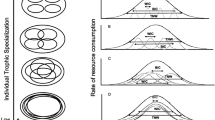Abstract
The coexistence of the Lakeland Downs short-tailed mouse Leggadina lakedownensis and house mouse Mus domesticus on Thevenard Island, in the arid north of Western Australia, prompted a study to compare their seasonal water and sodium metabolism using tritiated water and sodium-22 as tracers. Fractional water influx rates for M. domesticus (40.3 ± 1.6% total body-water day−1) were significantly higher than those for L. lakedownensis (25.3 ± 1.2% total body-water day−1). Water effluxes were higher in both species of mouse after the passage of a cyclonic storm near the study site. Water flux differences remained significant between species when turnover rates were scaled with body mass. A comparison of water influx rates of M. domesticus with those predicted for field populations of other eutherian rodents showed that rates for M. domesticus on Thevenard Island were higher than expected. In contrast, water influx rates for L. lakedownensis did not differ significantly from expected values for a desert rodent. Rates of sodium influx for M. domesticus (41.7 ± 3.6 mmol kg−1 day−1) were over twice those of L. lakedownensis (19.7 ± 4.8 mmol kg−1 day−1), and were reflected in the significantly higher concentrations of sodium ingested in the diet, and excreted in the urine, of M. domesticus. Furthermore, the rate of water influx was positively correlated with the rate of sodium influx in M. domesticus, suggesting that they were obtaining both water and sodium from the one dietary source. There was no evidence to suggest that mice of either species were experiencing water or sodium stress, because water and sodium influxes and effluxes remained in balance. These results suggest that M. domesticus on Thevenard Island had a higher-than-expected daily water requirement, and may represent a mesic deme of house mice that have yet to adapt to the island environment.
Similar content being viewed by others
Author information
Authors and Affiliations
Additional information
Accepted: 9 May 1999
Rights and permissions
About this article
Cite this article
Moro, D., Bradshaw, S. Water and sodium requirements of field populations of house mice (Mus domesticus) and short-tailed mice (Leggadina lakedownensis) on Thevenard Island, in the arid Pilbara region of Western Australia. J Comp Physiol B 169, 419–428 (1999). https://doi.org/10.1007/s003600050238
Issue Date:
DOI: https://doi.org/10.1007/s003600050238




